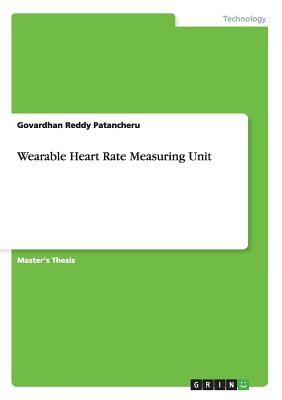
- We will send in 10–14 business days.
- Author: Govardhan Reddy Patancheru
- Publisher: GRIN Verlag
- Year: 2014
- Pages: 80
- ISBN-10: 3656697825
- ISBN-13: 9783656697824
- Format: 14.8 x 21 x 0.5 cm, softcover
- Language: English
- SAVE -10% with code: EXTRA
Reviews
Description
Master's Thesis from the year 2014 in the subject Electrotechnology, grade: A, Mid Sweden University, course: Electronic Design, language: English, abstract: Despite having the numerous evolved heart rate measuring devices and progress in their development over the years, there always remain the challenges of modern signal processing implementation by a comparatively small size wearable device. This thesis paper presents a wearable reflectance photoplethysmography (PPG) sensor system for measuring the heart rate of a user both in steady and moving states. The size and, power consumption of the device are considered while developing, to ensure an easy deployment of the unit at the measuring site and the ability to power the entire unit with a battery .The selection of both the electronic circuits and signal processing techniques is based on their sensitivity to PPG signals, robustness against noise inducing artifacts and miniaturization of the entire measuring unit. The entire signal chain operates in the discrete-time, which allows the entire signal processing to be implemented in firmware on an embedded microprocessor. The PPG sensor system is implemented on a single PCB that consumes around 7.5mW of power. Benchmarking tests with standard heart rate measuring devices reveal that the developed measurement unit (combination of the PPG sensor system, and inertial measurement unit (IMU) developed in-house at Acreo Swedish ICT, and a battery) is comparable to the devices in detecting heart rate even in motion artifacts environment. This thesis work is carried out in Acreo Swedish ICT, Gothenburg, Sweden in collaboration with MidSweden University, Sundsvall, Department of Electronics Design. This report can be used as ground work for future development of wearable heart rate measuring units at Acreo Swedish ICT.
EXTRA 10 % discount with code: EXTRA
The promotion ends in 19d.16:14:15
The discount code is valid when purchasing from 10 €. Discounts do not stack.
- Author: Govardhan Reddy Patancheru
- Publisher: GRIN Verlag
- Year: 2014
- Pages: 80
- ISBN-10: 3656697825
- ISBN-13: 9783656697824
- Format: 14.8 x 21 x 0.5 cm, softcover
- Language: English English
Master's Thesis from the year 2014 in the subject Electrotechnology, grade: A, Mid Sweden University, course: Electronic Design, language: English, abstract: Despite having the numerous evolved heart rate measuring devices and progress in their development over the years, there always remain the challenges of modern signal processing implementation by a comparatively small size wearable device. This thesis paper presents a wearable reflectance photoplethysmography (PPG) sensor system for measuring the heart rate of a user both in steady and moving states. The size and, power consumption of the device are considered while developing, to ensure an easy deployment of the unit at the measuring site and the ability to power the entire unit with a battery .The selection of both the electronic circuits and signal processing techniques is based on their sensitivity to PPG signals, robustness against noise inducing artifacts and miniaturization of the entire measuring unit. The entire signal chain operates in the discrete-time, which allows the entire signal processing to be implemented in firmware on an embedded microprocessor. The PPG sensor system is implemented on a single PCB that consumes around 7.5mW of power. Benchmarking tests with standard heart rate measuring devices reveal that the developed measurement unit (combination of the PPG sensor system, and inertial measurement unit (IMU) developed in-house at Acreo Swedish ICT, and a battery) is comparable to the devices in detecting heart rate even in motion artifacts environment. This thesis work is carried out in Acreo Swedish ICT, Gothenburg, Sweden in collaboration with MidSweden University, Sundsvall, Department of Electronics Design. This report can be used as ground work for future development of wearable heart rate measuring units at Acreo Swedish ICT.


Reviews